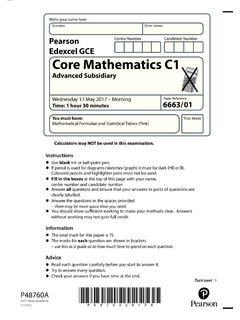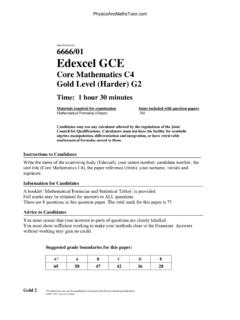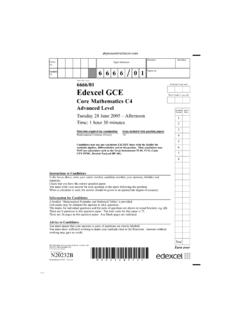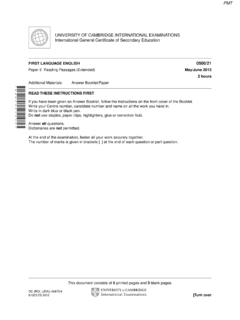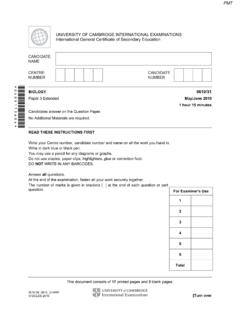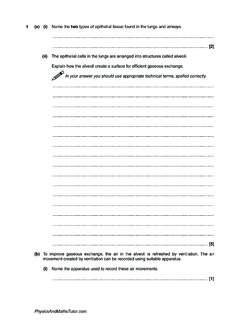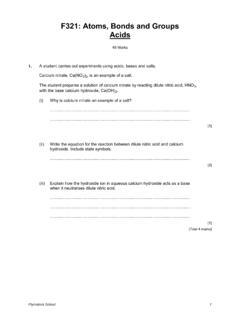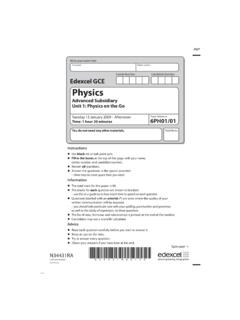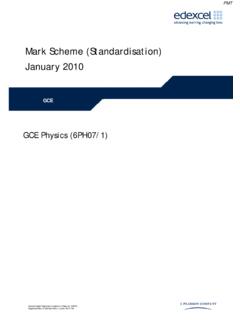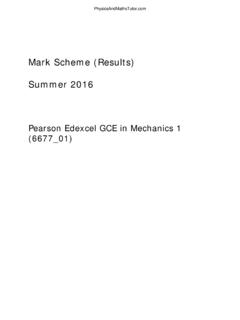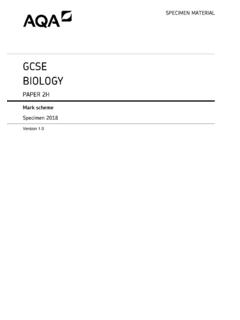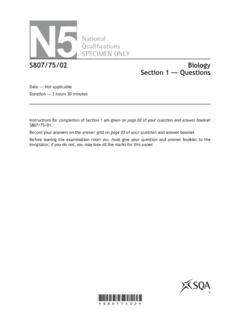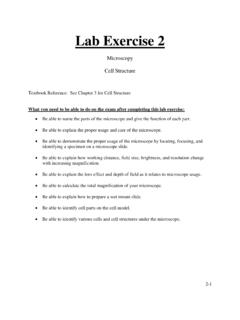Transcription of June 2020 QP - Paper 1 AQA Biology AS-level
1 Please write clearly in block capitals. Centre number Candidate number Surname Forename(s). Candidate signature I declare this is my own work. AS. Biology . Paper 1. Tuesday 19 May 2020 Afternoon Time allowed: 1 hour 30 minutes Materials For this Paper you must have: For Examiner's Use a ruler with millimetre measurements a scientific calculator. Question Mark 1. Instructions Use black ink or black ball-point pen. 2. Fill in the boxes at the top of this page. 3. Answer all questions. 4. You must answer the questions in the spaces provided. Do not write 5. outside the box around each page or on blank pages. If you need extra space for your answer(s), use the lined pages at the end of 6. this book. Write the question number against your answer(s). 7. Show all your working. 8. Do all rough work in this book. Cross through any work you do not want to be marked. 9. TOTAL. Information The marks for the questions are shown in brackets.
2 The maximum mark for this Paper is 75. *JUN207401101*. IB/M/Jun20/E12 7401/1. 2. Do not write outside the Answer all questions in the spaces provided. box 0 1 Figure 1 shows the structure of molecules found in organisms. Figure 1. 0 1 . 1 Complete Table 1 by putting the correct letter, A, B, C or D, in the box next to each statement. Each letter may be used once, more than once, or not at all. [4 marks]. Table 1. Letter Statement is a monomer in an enzyme's active site is a monomer in cellulose is produced during photosynthesis and respiration forms a polymer that gives a positive result with a biuret test *02*. IB/M/Jun20/7401/1. 3. Do not write outside the 0 1 . 2 Raffinose is a trisaccharide of three monosaccharides: galactose, glucose and box fructose. The chemical formulae of these monosaccharides are: galactose = C6H12O6. glucose = C6H12O6. fructose = C6H12O6. Give the number of carbon atoms, hydrogen atoms and oxygen atoms in a molecule of raffinose.
3 [1 mark]. Number of carbon atoms Number of hydrogen atoms Number of oxygen atoms 0 1 . 3 A biochemical test for reducing sugar produces a negative result with raffinose solution. Describe a biochemical test to show that raffinose solution contains a non-reducing sugar. [3 marks]. 8. Turn over . *03*. IB/M/Jun20/7401/1. 4. Do not write outside the 0 2 . 1 Explain the arrangement of phospholipids in a cell-surface membrane. box [2 marks]. 0 2 . 2 Describe how an ester bond is formed in a phospholipid molecule. [2 marks]. 0 2 . 3 State and explain the property of water that helps to prevent temperature increase in a cell. [2 marks]. Property Explanation 6. *04*. IB/M/Jun20/7401/1. 5. Do not write outside the 0 3 . 1 Describe how a phagocyte destroys a pathogen present in the blood. box [3 marks]. 0 3 . 2 Give two types of cell, other than pathogens, that can stimulate an immune response.
4 [2 marks]. 1. 2. Question 3 continues on the next page Turn over . *05*. IB/M/Jun20/7401/1. 6. Do not write outside the 0 3 . 3 Figure 2 shows the structure of an antibody. box Figure 2. Label Figure 2 with an X to show where an antigen-antibody complex forms. [1 mark]. 0 3 . 4 A disulfide bridge is labelled in Figure 2. What is the role of the disulfide bridge in forming the quaternary structure of an antibody? [1 mark]. 7. *06*. IB/M/Jun20/7401/1. 7. Do not write outside the 0 4 . 1 Eukaryotic cells produce and release proteins. box Outline the role of organelles in the production, transport and release of proteins from eukaryotic cells. Do not include details of transcription and translation in your answer. [4 marks]. Question 4 continues on the next page Turn over . *07*. IB/M/Jun20/7401/1. 8. Do not write outside the Figure 3 is a transmission electron micrograph of a plant cell.
5 Box Figure 3. 0 4 . 2 Suggest why a nucleus is not visible in Figure 3. [1 mark]. 0 4 . 3 Name the organelles labelled S and T in Figure 3. [1 mark]. Organelle S. Organelle T. 0 4 . 4 Give one advantage of viewing a biological specimen using a transmission electron microscope compared with using a scanning electron microscope. [1 mark]. *08*. IB/M/Jun20/7401/1. 9. Do not write outside the 0 4 . 5 The cells in Figure 4 are part of a continuous layer of cells forming the upper surface box of a leaf. The shaded area of cell U is 150 m2. The total area of the upper surface of the leaf is cm2. Figure 4. Calculate the number of cells in the upper surface of the leaf. Give the answer in standard form. Assume that all these cells are identical in size. Show your working. [2 marks]. Number of cells 9. Turn over . *09*. IB/M/Jun20/7401/1. 10. Do not write outside the 0 5 . 1 Describe and explain the mechanism that causes lungs to fill with air.
6 Box [3 marks]. A scientist observed sections of lung tissue using an optical microscope. Figure 5 shows one of these sections. K is an air-filled tube and L is a blood vessel. This figure has been removed due to third-party copyright restrictions. *10*. IB/M/Jun20/7401/1. 11. Do not write outside the 0 5 . 2 Identify the structures labelled K and L. box [1 mark]. K. L. 0 5 . 3 Two solutions often used to stain tissues are haematoxylin solution and iodine solution. Haematoxylin solution stains DNA a blue colour. Iodine solution stains starch a blue-black colour. The scientist used haematoxylin solution and not iodine solution to stain the lung tissue. Suggest why. [2 marks]. Question 5 continues on the next page Turn over . *11*. IB/M/Jun20/7401/1. 12. Do not write outside the 0 5 . 4 Scientists investigated the link between the lung disease asthma and three box risk factors. They studied a large number of people.
7 They recorded if the people had asthma and if they: were obese burned wood indoors as a fuel lived in a house with a cat or dog. The scientists used a statistical test to calculate the probability of the link between asthma and each risk factor being due to chance. Table 2 shows their results. Table 2. Probability Risk Factor (P value). Obese < Burned wood indoors = Lived with a cat or dog < A student who looked at these results concluded that all three risk factors are linked with asthma. Evaluate this conclusion. [3 marks]. 9. *12*. IB/M/Jun20/7401/1. 13. Do not write outside the 0 6 . 1 Describe how mRNA is produced from an exposed template strand of DNA. box Do not include DNA helicase or splicing in your answer. [3 marks]. 0 6 . 2 Define the term exon. [1 mark]. Question 6 continues on the next page Turn over . *13*. IB/M/Jun20/7401/1. 14. Do not write outside the Table 3 shows mRNA codons for some amino acids.
8 Box Table 3. Serine Proline Glycine Threonine Alanine UCU CCU GGA ACU GCA. UCC CCA GGG ACC GCG. 0 6 . 3 Figure 6 shows the DNA template nucleotide base sequence that determines the sequence of four amino acids. Figure 6. AGG CGT CCT GGA. Use information from Table 3 and Figure 6 to give the amino acid sequence determined by this sequence of nucleotides. [1 mark]. 0 6 . 4 A mutation in the nucleotide sequence shown in Figure 6 resulted in the following amino acid sequence. Serine Glycine Glycine Proline A student concluded that the mutation involved the addition of one nucleotide within the sequence shown in Figure 6. Does information in this question support the student's conclusion? Give reasons for your answer. [2 marks]. 7. *14*. IB/M/Jun20/7401/1. 15. Do not write outside the 0 7 . 1 Describe binary fission in bacteria. box [3 marks]. Question 7 continues on the next page Turn over.
9 *15*. IB/M/Jun20/7401/1. 16. Do not write outside the The cell growth rate of the bacterium Bacillus subtilis is proportional to its mass box immediately after binary fission. Figure 7 shows this relationship. Figure 7. 0 7 . 2 The mass of the bacterial cells was measured in femtograms (fg). 1 fg (femtogram) = 1 10 15 g Place a tick ( ) in the box next to the number that is equal to 680 fg [1 mark]. 000 000 006 8 g 10 13 g 10 15 g 10 17 g *16*. IB/M/Jun20/7401/1. 17. Do not write outside the A scientist determined the growth rate of a B. subtilis cell by measuring its mass for box 5 minutes. In those 5 minutes, the cell's mass increased by 90 fg 0 7 . 3 Use this information and Figure 7 to determine the mass of this cell immediately after binary fission. Show your working. [2 marks]. Answer fg 0 7 . 4 Suggest and explain how two environmental variables could be changed to increase the growth rate of these cells.
10 [4 marks]. Suggestion 1. Explanation Suggestion 2. Explanation 10. Turn over . *17*. IB/M/Jun20/7401/1. 18. Do not write outside the 0 8 A scientist investigated birth mass in a population of babies. She determined the box birth mass (b) of babies and grouped this information into different ranges of birth mass. Her results are shown in Table 4. Table 4. Birth mass b / kg Range of Frequency mass / kg density < b 5 000. < b 20 000. < b 90 000. < b 260 000. < b 200 000. < b 20 000. Frequency density is calculated using this equation number of babies Frequency density =. range of mass *18*. IB/M/Jun20/7401/1. 19. Do not write outside the 0 8 . 1 Draw, on Figure 8, a suitable chart to show the distribution of birth mass for this box population of babies. [4 marks]. Figure 8. 0 8 . 2 Babies with birth mass less than kg are classified as low birth mass. Use information in Table 4 and the equation to calculate the number of babies born with low birth mass in this population.
